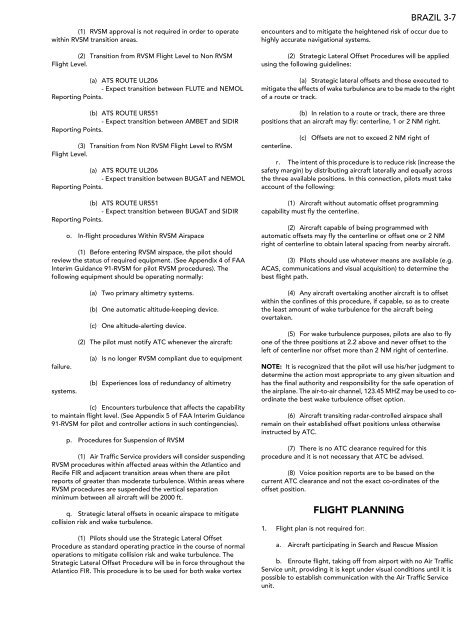NORTH AND SOUTH AMERICA - CNATRA - The US Navy
NORTH AND SOUTH AMERICA - CNATRA - The US Navy
NORTH AND SOUTH AMERICA - CNATRA - The US Navy
You also want an ePaper? Increase the reach of your titles
YUMPU automatically turns print PDFs into web optimized ePapers that Google loves.
(1) RVSM approval is not required in order to operate<br />
within RVSM transition areas.<br />
(2) Transition from RVSM Flight Level to Non RVSM<br />
Flight Level.<br />
(a) ATS ROUTE UL206<br />
- Expect transition between FLUTE and NEMOL<br />
Reporting Points.<br />
(b) ATS ROUTE UR551<br />
- Expect transition between AMBET and SIDIR<br />
Reporting Points.<br />
(3) Transition from Non RVSM Flight Level to RVSM<br />
Flight Level.<br />
(a) ATS ROUTE UL206<br />
- Expect transition between BUGAT and NEMOL<br />
Reporting Points.<br />
(b) ATS ROUTE UR551<br />
- Expect transition between BUGAT and SIDIR<br />
Reporting Points.<br />
o. In-flight procedures Within RVSM Airspace<br />
(1) Before entering RVSM airspace, the pilot should<br />
review the status of required equipment. (See Appendix 4 of FAA<br />
Interim Guidance 91-RVSM for pilot RVSM procedures). <strong>The</strong><br />
following equipment should be operating normally:<br />
failure.<br />
systems.<br />
(a) Two primary altimetry systems.<br />
(b) One automatic altitude-keeping device.<br />
(c) One altitude-alerting device.<br />
(2) <strong>The</strong> pilot must notify ATC whenever the aircraft:<br />
(a) Is no longer RVSM compliant due to equipment<br />
(b) Experiences loss of redundancy of altimetry<br />
(c) Encounters turbulence that affects the capability<br />
to maintain flight level. (See Appendix 5 of FAA Interim Guidance<br />
91-RVSM for pilot and controller actions in such contingencies).<br />
p. Procedures for Suspension of RVSM<br />
(1) Air Traffic Service providers will consider suspending<br />
RVSM procedures within affected areas within the Atlantico and<br />
Recife FIR and adjacent transition areas when there are pilot<br />
reports of greater than moderate turbulence. Within areas where<br />
RVSM procedures are suspended the vertical separation<br />
minimum between all aircraft will be 2000 ft.<br />
q. Strategic lateral offsets in oceanic airspace to mitigate<br />
collision risk and wake turbulence.<br />
(1) Pilots should use the Strategic Lateral Offset<br />
Procedure as standard operating practice in the course of normal<br />
operations to mitigate collision risk and wake turbulence. <strong>The</strong><br />
Strategic Lateral Offset Procedure will be in force throughout the<br />
Atlantico FIR. This procedure is to be used for both wake vortex<br />
BRAZIL 3-7<br />
encounters and to mitigate the heightened risk of occur due to<br />
highly accurate navigational systems.<br />
(2) Strategic Lateral Offset Procedures will be applied<br />
using the following guidelines:<br />
(a) Strategic lateral offsets and those executed to<br />
mitigate the effects of wake turbulence are to be made to the right<br />
of a route or track.<br />
(b) In relation to a route or track, there are three<br />
positions that an aircraft may fly: centerline, 1 or 2 NM right.<br />
centerline.<br />
(c) Offsets are not to exceed 2 NM right of<br />
r. <strong>The</strong> intent of this procedure is to reduce risk (increase the<br />
safety margin) by distributing aircraft laterally and equally across<br />
the three available positions. In this connection, pilots must take<br />
account of the following:<br />
(1) Aircraft without automatic offset programming<br />
capability must fly the centerline.<br />
(2) Aircraft capable of being programmed with<br />
automatic offsets may fly the centerline or offset one or 2 NM<br />
right of centerline to obtain lateral spacing from nearby aircraft.<br />
(3) Pilots should use whatever means are available (e.g.<br />
ACAS, communications and visual acquisition) to determine the<br />
best flight path.<br />
(4) Any aircraft overtaking another aircraft is to offset<br />
within the confines of this procedure, if capable, so as to create<br />
the least amount of wake turbulence for the aircraft being<br />
overtaken.<br />
(5) For wake turbulence purposes, pilots are also to fly<br />
one of the three positions at 2.2 above and never offset to the<br />
left of centerline nor offset more than 2 NM right of centerline.<br />
NOTE: It is recognized that the pilot will use his/her judgment to<br />
determine the action most appropriate to any given situation and<br />
has the final authority and responsibility for the safe operation of<br />
the airplane. <strong>The</strong> air-to-air channel, 123.45 MHZ may be used to coordinate<br />
the best wake turbulence offset option.<br />
(6) Aircraft transiting radar-controlled airspace shall<br />
remain on their established offset positions unless otherwise<br />
instructed by ATC.<br />
(7) <strong>The</strong>re is no ATC clearance required for this<br />
procedure and it is not necessary that ATC be advised.<br />
(8) Voice position reports are to be based on the<br />
current ATC clearance and not the exact co-ordinates of the<br />
offset position.<br />
FLIGHT PLANNING<br />
1. Flight plan is not required for:<br />
a. Aircraft participating in Search and Rescue Mission<br />
b. Enroute flight, taking off from airport with no Air Traffic<br />
Service unit, providing it is kept under visual conditions until it is<br />
possible to establish communication with the Air Traffic Service<br />
unit.

















